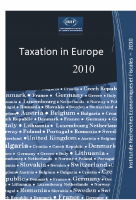IREF is presenting for the third consecutive year a unique report on taxation in Europe. You can find here expert analysis of the fiscal policy in 22 european countries, the most recent data and forecast for future developments. Summary by Professor Pierre Garello.
A financial crisis or the crisis of the modern State?
Prior to the 2008 crisis, the overall tax ratio in the EU-zone had been increasing for three years in a row and was back to the record level of 1999. Then came the crisis and with it the perspective of a drop in gross domestic product and, consequently, of tax revenues. With the exception of Poland, production has been decreasing everywhere in 2009. Where data on tax revenues are available, we also get confirmation that tax revenues in many cases went down; they represent a lower share of a lower GDP (again with some exceptions such as Bulgaria, Lithuania or Switzerland).
Clearly, most—may be all—of the fall in the overall tax ratio that we observed in 2009 had little to do with the desire to reduce public expenditures. If it has certainly something to do with the desire to boost consumption, with more generous tax allowances for instance, the truth isthat it was imposed on government. It was, indeed, an instance of a fiscal constraint tying the hands of governments in their attempts to react to the crisis. And the constraint was reinforced by the fact that many European countries were, even before the crisis occurred, already struggling to maintain public debt at a reasonable level.
What did governments do in such a tight financial situation? Again, the data speak clearly: governments did their best to maintain public expenditures. As a matter of fact, the share of public expenditures to GDP increased almost everywhere (see table). This increase has two causes. First, governments have attempted to boost their economy with new expenditures such as incentive schemes to replace old cars with new ones. But more importantly many governments were stuck with mandatory spending that automatically generated an increase of the share of government spending to GDP when GDP fell off.
Whatever may be our appreciation of the success of these fiscal and budgetary policies, a pressing question remains: what comes next? Again, looking at the table we clearly see that public debt and public deficit have both soared literally everywhere. Will the various governments be able to reduce public spending and public debt in the future, and if not, what will happen? Some may point out the alleged virtue of so-called automatic stabilizers and argue that when growth returns, tax revenues will automatically increase and absorb the debt; and indeed many budget laws passed in 2010 are based on this kind of scenario. There are good reasons, however, to question such optimistic predictions. For what 2009 teaches us is precisely that most governments have few degrees of freedom. Deficits are structural and debts are not here to promote investment but mandatory expenditures; there is therefore little hope that things will go back to normal when growth reappears. Could it be then that Nation States have just grown too large?
One escape route for 2010 could be to tax personal incomes a bit more (we must remember that, as we will see later and contrarily to what is often claimed, the implicit rate on capital income has increased). But isn’t this routea dead end? Up to what point will people be ready to work and invest to pay for benefits clearly accruing to others?
Another solution could be to borrow more on the financial market. This is relatively easy; so easy that it is apparently hard for some governments to resist the temptation. But this route, as is well known, is also full of unpleasant surprises. First, there is the cost for the coming generations who will have to make the efforts that their parents kept postponing. Second, because the money lent to governments for mandatory expenditures is missing for private investment. And finally because, as the experience of Greece reminds us, actors on the financial market traditionally become reluctant at some point to finance social benefits and inefficiencies that do not create wealth.
The misnamed “financial crisis” of 2008 reveals the urgency to reflect on the role of the State for the coming years. Unfortunately, little was done in 2009 in that direction.



